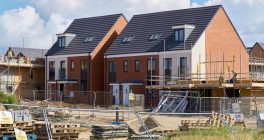Construction activity and new orders increased in June 2024 but more slowly than in May as house-building slowed again.
The headline S&P Global UK Construction Purchasing Managers’ Index (PMI) registered 52.2 in June, down from 54.7 in May, but above the 50.0 no-change mark for the fourth consecutive month.
The main driver of growth continued to come from commercial activity, which increased markedly again in June. However, the rate of expansion softened from May’s two-year high. A slower increase in civil engineering activity was also recorded, with output up modestly. The only category to record a drop in activity was house-building, where output fell solidly following a first increase in 19 months during May.
Anecdotal evidence suggested that the expansion in total activity reflected the securing of new contracts during the month. Data on new orders showed a fifth consecutive monthly expansion amid successful tendering and a rise in client activity. That said, the rate of growth in new business was only modest and the slowest since February. Some respondents indicated that uncertainty as a result of the general election being called had caused new work inflows to slow.
Despite a softer expansion in new orders, construction firms responded to greater workloads by taking on additional staff for the second month running. Moreover, the rate of job creation was solid and the sharpest since August last year.
Rising new orders also led firms to increase their purchasing activity for the second month running, with the rate of expansion little changed from that seen in May.
There remained little sign of pressure on supply chains, however, with vendor delivery times shortening for the 16th consecutive month. Meanwhile, input costs rose only slightly again in June as some suppliers limited price rises in an effort to secure new business. The rate of inflation ticked higher amid rising costs for some raw materials, but remained well below the series average. Meanwhile, subcontractor rates also increased modestly, and at the slowest pace in four months.
Confidence in their ability to secure new contracts over the coming year supported continued optimism in the 12-month outlook for construction activity in June. Expectations that interest rates will start to come down also contributed to positive sentiment. More than half of respondents predicted an increase in construction activity, with the level of confidence broadly in line with that seen in May.
Andrew Harker, economics director at S&P Global Market Intelligence, which compiles the monthly PMI surveys, said: “Continued growth of the UK construction sector in June meant that the sector has recorded sustained expansion throughout the second quarter of the year. While there were signs of a slowdown in the latest survey period, most notably around housing activity, firms indicated that a slowdown in new order growth was in part related to election uncertainty. We may therefore see trends improve once the election period comes to an end.
“Moreover, confidence in the year ahead outlook remained strong and firms increased employment to the largest extent in 10 months.
“In terms of inflation, there remains little sign of cost pressures picking up to any great extent, encouraging firms to expand purchasing activity. Supply-chain conditions also remained favourable.”
Fraser Johns, finance director at building contractor Beard, said: “Such is the UK construction sector’s continued growth, even renewed challenges in house building – which can often have a dragging effect on output as a whole – wasn’t enough to halt its expansion. And while this general election period has naturally had an impact on new order volumes – as some clients wait to see the outcome and the lay of the land – we still saw growth for a fifth consecutive month.
“With inflationary pressures having eased, and encouraging supply chain conditions are all helping to drive momentum and increase confidence for the second half of the year. It comes as no surprise to us at Beard to see the commercial sector moving the needle, with persistent demand across our five regional offices and from both national and regional frameworks. Once we have the results of today’s election and the dust settles, we can certainly expect to see more clients push ahead with plans.
“Even as conditions improve, a sensible approach to tendering and cost plans will always be needed, as will close communications with subcontractors, clients and suppliers to ensure we all deliver the best possible outcomes.”





